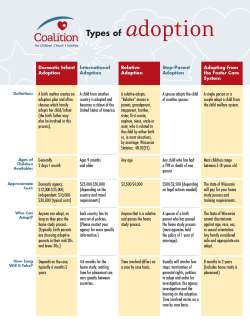Families choose adoption for a variety of reasons and there are a lot of decisions to be made throughout the entire process. One of the first choices to make, is the type of adoption you would like to pursue and what your first steps would be after deciding.
 Below are the three most common types of adoptions and an explanation of what the initial or next step might look like for each one:
Below are the three most common types of adoptions and an explanation of what the initial or next step might look like for each one:
- A domestic infant adoption takes placewhen a birth mother and/or birth father have individually or jointly made an adoption plan for their child. Often, birth parents will be able to work with a private adoption agency and get to choose the family they wish to have adopt their child. Other times, the agency will do the matching when a birth parent has elected not to be a part of the family selection process.
First steps: In Wisconsin, families wanting to pursue a domestic infant adoption would first be required to select a private adoption agency licensed by the State of Wisconsin to complete their adoption home study.
- An international adoption is when a couple or individual from the United States adopts a child from another country. Each country has its own rules for whether they will allow single people, unmarried couples, people of a certain age, etc. to adopt.
First steps: In Wisconsin, families wanting to pursue an international adoption would first be required to select a private adoption agency licensed by the State of Wisconsin that is able to complete your international adoption home study and be your placing agency or able to work with a placing agency of your choice. (Please note that some private adoption agencies will be able to both complete your home study and be your placing agency, while others will only be able to complete your home study and work with your selected placing agency, based on the country you wish to adopt from.)
- Special needs adoption, also known as adoption of a child from foster care, is when a family adopts a child who is in foster care and who cannot be successfully reunited with his or her birth family for a number of reasons.
First steps: For Wisconsin families who have decided to adopt a child who is in foster care in Wisconsin, your first step would be to contact the regional Department of Children and Families office for your county and register to attend a mandatory two-hour informational meeting with the State Special Needs Adoption Program.
For Wisconsin families who wish to adopt a child who is in foster care in a state other than Wisconsin, your first step would be to connect with a private adoption agency licensed by the State of Wisconsin to complete your adoption home study.
There are several other types of adoption not mentioned above, including, but not limited to, independent adoptions, relative adoptions, stepparent adoptions, and adult adoptions.
For more information about adoption in general, please contact us and ask to speak with a Resource Specialist. You can call us at 1-800-762-8063, locally at 414-475-1246, or reach us via email at info@coalitionforcyf.org. In addition, you can also gather more information from our website, where you can download an informational packet on a specific type of adoption.
 away’ part. I’d fallen in love with him the moment our eyes met, and the thought of letting him go was devastating. But it wasn’t about me. And for his sake, I wished for a happy healthy reunification. But it just wasn’t meant to be. A couple of years passed and I was asked if I’d be willing to adopt. A couple more years passed, and we had an adoption date. I remember every detail of that day. He wore little cuffed corduroys, an oxford shirt, and suede wingtips. I remember family and friends with balloons and cameras at the ready. I remember the judge letting him bang the gavel to finalize his own adoption.
away’ part. I’d fallen in love with him the moment our eyes met, and the thought of letting him go was devastating. But it wasn’t about me. And for his sake, I wished for a happy healthy reunification. But it just wasn’t meant to be. A couple of years passed and I was asked if I’d be willing to adopt. A couple more years passed, and we had an adoption date. I remember every detail of that day. He wore little cuffed corduroys, an oxford shirt, and suede wingtips. I remember family and friends with balloons and cameras at the ready. I remember the judge letting him bang the gavel to finalize his own adoption. finalization of an adoption is the happy ending to what has often been a lengthy, nerve-wracking, emotional roller coaster ride. What possible reason could there be to be depressed when it finally ends?
finalization of an adoption is the happy ending to what has often been a lengthy, nerve-wracking, emotional roller coaster ride. What possible reason could there be to be depressed when it finally ends?
 One of the first sights you’ll take in if you’re able to drop into our office here at the Coalition for Children, Youth & Families, is walls of books, CDs and DVDs, framing a comfortable seating area. We take pride in offering a large, ever-growing selection of informative and supportive books and teaching tools to families and child welfare workers throughout the state of Wisconsin, for free!
One of the first sights you’ll take in if you’re able to drop into our office here at the Coalition for Children, Youth & Families, is walls of books, CDs and DVDs, framing a comfortable seating area. We take pride in offering a large, ever-growing selection of informative and supportive books and teaching tools to families and child welfare workers throughout the state of Wisconsin, for free! But then the call came — a child needs a home. Suddenly your excitement turns to apprehension. Are you really ready?
But then the call came — a child needs a home. Suddenly your excitement turns to apprehension. Are you really ready?

 Certainly Mitch and Cam are loving parents, so where did they go wrong?
Certainly Mitch and Cam are loving parents, so where did they go wrong?

 Foster Parents muster a myriad of skills to care for the children in their home and ensure their journey through the foster care system is as smooth as possible. Below are 7 key skills the most successful foster parents employ on a daily basis.
Foster Parents muster a myriad of skills to care for the children in their home and ensure their journey through the foster care system is as smooth as possible. Below are 7 key skills the most successful foster parents employ on a daily basis. Finding yourself pregnant and at a crossroads of decision-making is often very stressful and confusing, and you may even feel alone and scared. All of your options can seem like they lead to so many unknowns and you may not have anyone in your life who has been in your shoes to offer guidance and support. As you consider adoption, we want to ensure that you have access to accurate information, free of bias and pressure, as well as emotional support along the way.
Finding yourself pregnant and at a crossroads of decision-making is often very stressful and confusing, and you may even feel alone and scared. All of your options can seem like they lead to so many unknowns and you may not have anyone in your life who has been in your shoes to offer guidance and support. As you consider adoption, we want to ensure that you have access to accurate information, free of bias and pressure, as well as emotional support along the way. Much like everything else around us, adoption has progressively changed and will very likely continue to evolve over time. The earliest adoptions consisted of informal kinship or other informal adoptions of children into non-relative families; there were few to no laws or guidelines in place to protect children or families. Over the years, all 50 states in the US and even many international countries have since developed their own adoption laws and guidelines to be able to ensure best practice. Adoptions have also expanded over the years to include several different types of adoption: traditional independent/infant domestic adoptions, adoption of child from foster care (or Special Needs Adoption), international adoption, and step-parent adoption.
Much like everything else around us, adoption has progressively changed and will very likely continue to evolve over time. The earliest adoptions consisted of informal kinship or other informal adoptions of children into non-relative families; there were few to no laws or guidelines in place to protect children or families. Over the years, all 50 states in the US and even many international countries have since developed their own adoption laws and guidelines to be able to ensure best practice. Adoptions have also expanded over the years to include several different types of adoption: traditional independent/infant domestic adoptions, adoption of child from foster care (or Special Needs Adoption), international adoption, and step-parent adoption.